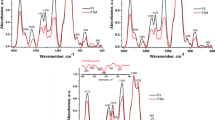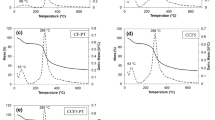Abstract
This study aimed to develop and characterize biodegradable films containing mucilage, chitosan and polyvinyl alcohol (PVA) in different concentrations. The films were prepared by casting on glass plates using glycerol as plasticizer. Mechanical properties, water vapor and oxygen barrier, as well as the interaction with water, were measured. The compatibility of the film-forming components and the uniformity of the films were determined by zeta potential and SEM, respectively. The glycerol and mucilage allowed obtaining more hydrophilic films. The barrier properties of the films made from 100 % chitosan were similar to composed films containing PVA up to 40 %. The results of this study suggest that the interaction between chitosan and mucilage could increase water vapor permeability. The films prepared from either 100 % chitosan or PVA showed a more hydrophobic behavior as compared to the composed films. The films were homogenous since no boundary or separation of components was observed, indicating a good compatibility of the components in the films.



Similar content being viewed by others
References
Olivas GI, Barbosa-Cánovas G (2009) In: Embruscado ME, Huber KC (eds) Edible films and coatings for food applicatios. Springer, NewYork, pp 211–238
Bourtoom T (2008) Edible films and coatings: characteristics and properties. Int Food Res J 15:237–248
Tharanathan RN (2003) Biodegradable films and composite coatings: past, present and future. Trends Food Sci Technol 14:71–78
Aguilar KC, Tello F, Bierhalz ACK, Garnica Romo MG, Martínez Flores HE, Grosso CRF (2015) Protein adsorption onto alginate-pectin microparticles and films produced by ionic gelation. J Food Eng 154:17–24
Durango AM, Soares NFF, Arteaga MR (2011) Filmes y revestimientos comestibles como empaques activos biodegradables en la conservación de alimentos. Biotecnología en el Sector Agropecuario y Agroindustrial 9:122–128
Vásconez MB, Flores SK, Campos CA, Alvarado J, Gerschenson LN (2009) Antimicrobial activity and physical properties of chitosan–tapioca starch based edible films and coatings. Food Res Int 42:762–769
Durango AM, Soares NFF, Andrade NJ (2006) Microbiological evaluation of an edible antimicrobial coating on minimally processed carrots. Food Control 17:336–341
Fang SW, Li CF, Shih DYC (1994) Antifungal activity of chitosan and its preservative effect on low-sugar candied kumquat. J Food Prot 57:136–140
Muzzarelli R, Tarsi R, Filippini O, Giovanetti E, Biagini G, Varaldo PE (1990) Antimicrobial properties of N-carboxybutyl chitosan. Antimicrob Agents Chemother 34:2019–2023
Latorre-Salamanca LE, Perez-Cabrera LE, Diaz-Narvaez GC, Barba-deAlba LR (2011) Linseed mucilage and chitosan composite films: preparation, physical, mechanical and microstructure properties. In: Linseed mucilage and chitosan composite films: preparation, physical, mechanical and microstructure properties, iCEF 11 international congress on engineering and foods, Athens, Greece
Medina-Torres L, Brito-De La Fuente E, Torrestiana-Sanchez B, Katthain R (2000) Rheological properties of the mucilage gum (Opuntia ficus indica). Food Hydrocoll 14:417–424
Rodríguez-González S, Martínez-Flores HE, Chávez-Moreno CK, Macías-Rodríguez LI, Zavala-Mendoza E, Garnica-Romo MG, Chacón-García L (2014) Extraction and characterization of mucilage from wild species of opuntia. J Food Process Eng 37:285–292
Sánchez E, Dávila-Aviña J, Castillo SL, Heredia N, Vázquez-Alvarado R, García S (2014) Antibacterial and antioxidant activities in extracts of fully grown cladodes of 8 cultivars of cactus pear. J Food Sci 79:M659–M664
Sanchez E, Garcia S, Heredia N (2010) Extracts of edible and medicinal plants damage membranes of vibrio cholerae. Appl Environ Microbiol 76:6888–6894
Gallegos-Infante JA, Rocha-Guzman NE, Gonzalez-Laredo RF, Reynoso-Camacho R, Medina-Torres L, Cervantes-Cardozo V (2009) Effect of air flow rate on the polyphenols content and antioxidant capacity of convective dried cactus pear cladodes (Opuntia ficus indica). Int J Food Sci Nutr 60(Suppl 2):80–87
Espino-Diaz M, de Jesus Ornelas-Paz J, Martinez-Tellez MA, Santillan C, Barbosa-Canovas GV, Zamudio-Flores PB, Olivas GI (2010) Development and characterization of edible films based on mucilage of Opuntia ficus-indica (L.). J Food Sci 75:E347–E352
Srinivasa PC, Ramesh MN, Kumar KR, Tharanathan RN (2003) Properties and sorption studies of chitosan–polyvinyl alcohol blend films. Carbohydr Polym 53:431–438
Rafique A, Mahmood Zia K, Zuber M, Tabasum S, Rehman S (2016) Chitosan functionalized poly(vinyl alcohol) for prospects biomedical and industrial applications: a review. Int J Biol Macromol 87:141–154
Bonilla J, Fortunati E, Atarés L, Chiralt A, Kenny JM (2014) Physical, structural and antimicrobial properties of poly vinyl alcohol–chitosan biodegradable films. Food Hydrocoll 35:463–470
Wnuk-Andrew J, Melik-David H, Young-Terrill A (1995) Composiciones de peliculas monocapas biodegradables, impermeables a los liquidos. In: P&G (ed) Oficina Española De Patentes Y Marcas, España, p 24
Villagómez-Zavala DL, Gómez-Corona C, San Martín Martínez E, Pérez-Orozco JP, Vernon-Carter EJ, Pedroza-Islas R (2008) Comparative study of the mechanical properties of edible films made from single and blended hydrophilic biopolymer matrices. Revista mexicana de ingeniería química 7:263–273
Zamora-Vega R, Montanez-Soto JL, Martinez-Flores HE, Flores-Magallon R, Munoz-Ruiz CV, Venegas-Gonzalez J, Ariza Ortega Tde J (2012) Effect of incorporating prebiotics in coating materials for the microencapsulation of Saccharomyces boulardii. Int J Food Sci Nutr 63:930–935
Coupland JN, Shaw NB, Monahan FJ, Dolores O’Riordan E, O’Sullivan M (2000) Modeling the effect of glycerol on the moisture sorption behavior of whey protein edible films. J Food Eng 43:25–30
ASTM-D882 (2012) Standard test method for tensile properties of thin plastic sheeting, USA
ASTM-E96/E96 M (2010) Standard test methods for water vapor transmission of materials, USA
Aguirre-Loredo RY, Rodríguez-Hernández AI, Morales-Sánchez E, Gómez-Aldapa CA, Velazquez G (2016) Effect of equilibrium moisture content on barrier, mechanical and thermal properties of chitosan films. Food Chem 196:560–566
Romero-Bastida CA, Flores-Huicochea E, Martin-Polo MO, Velazquez G, Torres JA (2004) Compositional and moisture content effects on the biodegradability of zein/ethylcellulose films. J Agric Food Chem 52:2230–2235
Ostolska I, Wiśniewska M (2014) Application of the zeta potential measurements to explanation of colloidal Cr(2)O(3) stability mechanism in the presence of the ionic polyamino acids. Colloid Polym Sci 292:2453–2464
Clogston JD, Patri AK (2011) Zeta Potential Measurement. In: McNeil ES (ed) Characterization of nanoparticles intended for drug delivery. Humana Press, Totowa, NJ, pp 63–70
Ma S, Chen F, Ye X, Dong Y, Xue Y, Xu H, Zhang W, Song S, Ai L, Zhang N, Pan W (2013) Intravenous microemulsion of docetaxel containing an anti-tumor synergistic ingredient (Brucea javanica oil): formulation and pharmacokinetics. Int J Nanomed 8:4045–4052
Salem HF, Ahmed SM, Hassaballah AE, Omar MM (2015) Targeting brain cells with glutathione-modulated nanoliposomes: in vitro and in vivo study. Drug Des Dev Ther 9:3705–3727
Kadir MFZ, Majid SR, Arof AK (2010) Plasticized chitosan-PVA blend polymer electrolyte based proton battery. Electrochim Acta 55:1475–1482
Suyatma NE, Copinet A, Tighzert L, Coma V (2004) Mechanical and barrier properties of biodegradable films made from chitosan and poly (lactic acid) blends. J Polym Environ 12:1–6
Vieira MGA, da Silva MA, dos Santos LO, Beppu MM (2011) Natural-based plasticizers and biopolymer films: a review. Eur Polym J 47:254–263
Gueguen J, Viroben G, Noireaux P, Subirade M (1998) Influence of plasticizers and treatments on the properties of films from pea proteins. Ind Crops Prod 7:149–157
Leceta I, Guerrero P, de la Caba K (2013) Functional properties of chitosan-based films. Carbohydr Polym 93:339–346
Bonilla J, Atarés L, Vargas M, Chiralt A (2012) Edible films and coatings to prevent the detrimental effect of oxygen on food quality: possibilities and limitations. J Food Eng 110:208–213
Ribeiro C, Vicente AA, Teixeira JA, Miranda C (2007) Optimization of edible coating composition to retard strawberry fruit senescence. Postharvest Biol Technol 44:67–70
McHugh TH, Krochta JM (1994) Sorbitol- versus glycerol-plasticized whey protein edible films: integrated oxygen permeability and tensile property evaluation. J Agric Food Chem 42:841–845
Acknowledgments
We want to acknowledge to Mr. Luciano B. Rusciolelli for his support in oxygen permeability measurements, Luz Ma. Reyna Avilés Arellano from Cinvestav-IPN, campus Querétaro for helping us with the zeta potential and Cecilia Sánchez Cortez, James Pan and Tina Williams for the support for this work. We thank to CONACYT Mexico for financial support provided and the scholarship grant from BEIFI-IPN.
Author information
Authors and Affiliations
Corresponding author
Ethics declarations
Conflict of interest
The authors declare that we have no conflict of interest.
Rights and permissions
About this article
Cite this article
Dominguez-Martinez, B.M., Martínez-Flores, H.E., Berrios, J.D.J. et al. Physical Characterization of Biodegradable Films Based on Chitosan, Polyvinyl Alcohol and Opuntia Mucilage. J Polym Environ 25, 683–691 (2017). https://doi.org/10.1007/s10924-016-0851-y
Published:
Issue Date:
DOI: https://doi.org/10.1007/s10924-016-0851-y




